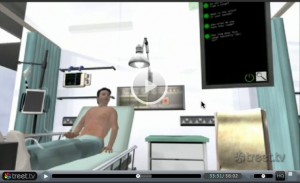This week Dave Taylor/Davee Commerce and Robin Winter had a special on Treet.tv about lots of the virtual world projects in Second Life that Imperial College London have been up to. It is a great show to watch to see the variety of ways Dave has got Second Life working from public information, targeted patient experiments and doctor training.

The doctor training and evaluation that appears around about 32 mins in Dave says. “This is where we have our virtual patients, and these patients are controlled by software actually outside of Second Life. That software has a knowledge of the patients physiology and condition.” He also explains there are 3 wards and 3 patients in each giving 9 levels of difficulty in scenario.
“We are using this to research how we can asses trainee doctors at different levels of training”. “We have tested about 60 doctors so far on this”.
I am glad this is out in the public as this has been part of the work I have been doing in SL. I can’t explain exactly what does what as its a private project but as Dave points out the patients and the interactions are controlled from outside of Second Life, my part in SL is the broker talking to that external model. I also ended up building the dynamic menus and handlers in world. The menu’s are based on the data coming back, and align to the correct place in world so they are designer friendly. This was built before the web on a prim existed, and we aimed to do everything in world. As you know handling text can be a problem in SL and variants of Fasttext and xy text came to rescue. Though rezzing a dynamic button and making it know what it is supposed to do is a non trivial task. This was also before HTTP in world servers were stable so SL is the controller asking the external software what to do next.
It has been a fascinating project, as has its follow on ones that have increased in complexity and in interactions. Making SL a component in a system not the sole piece of the project makes for a greater richness and flexibility. After all SL is not a database/data handling application.
What is great is that Robin, who is one of SL’s foremost designers (along with his other half) and has been for years(he built the original Dublin sim), is able to craft animations and objects and then trigger them into existence using our message protocol, after the external software model tells my broker code that its got some changes to display.
There are a few of us pushing the bondaries of data interchange with SL and also with opensim and other virtual worlds. I hope this helps people understand that we can do very complex integrated tasks using the best of a Virtual World and the best of a traditional server application. Integration is the key.

Leave a Reply